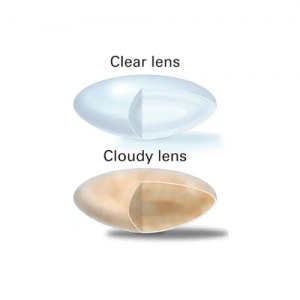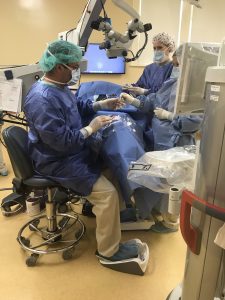Cataract Diagnosis and Treatment

A clear natural lens vs. a cloudy natural lens with a cataract.
Our goal during Cataract Awareness Month (a.k.a. June) is to increase the public’s awareness, knowledge, and understanding of cataracts. This includes the causes, symptoms, risk factors, diagnosis, and treatment of cataracts. That being said, you may be wondering how your eye doctor can even go about diagnosing a cataract and what surgery is like, or what to do if you have cataracts in both eyes… we will cover all of that here. It’s always nice having an idea of what to expect when going into a new situation/experience, so we’ve got you covered.
If you’re new here, a cataract is when your eye’s natural lens becomes cloudy and your vision becomes blurry, among other possible symptoms. If left untreated, a cataract can lead to blindness. Luckily, cataract surgery is one of the safest and most common operations done at this time.
There are several tests your eye doctor will do during a comprehensive eye exam that will determine if you have a cataract:
- Ask about your general medical history as well as your specific eye history (including problems and symptoms)
- Test your vision (visual acuity test) and your side vision (peripheral vision)
- Test your eye movement
- Measure each eye’s internal pressure to test for glaucoma
- Assess the thickness of the cataract by conducting a microscopic exam with a slit lamp to see how the cataract interferes with light passing through the lens
- Dilate (widen) the pupils of your eyes to determine the retina, optic nerve, and macula
- Test how glare affects your vision
If you are diagnosed with a cataract, surgery is unfortunately the only treatment at this time. There are myths that cataracts can be treated with eye drops or medicines but that has not been a proven or FDA-approved treatment at this time. Another myth is that taking Vitamins E or C can prevent a cataract. Again, this has not yet been proven to be true, though it may be possible that a particular vitamin-rich diet could be protective against cataracts. Like we said, neither of these have been proven yet, however, there are active studies looking into both of these topics. But for now, surgery is the only way to completely get rid of a cataract.
The good news though is that just because you have a cataract, even in both eyes, it does not mean you need to get them removed right away. Cataract surgery is an elective surgery where it is the patients’ choice when to undergo the procedure. Most patients wait to have surgery until the vision loss from the cataract is interfering with day-to-day activities. A patient may also have to undergo surgery sooner than later if the cataract is preventing treatment for another eye disease. No matter the case, you and your eye doctor will make the decision together that works best for the both of you. Now to the question of having a cataract in each eye… if this is the case, your eye doctor or eye surgeon will suggest having the cataract removed from one eye first then the second eye at a later date once the first eye has healed.
Ophthalmologists are usually the surgeons for cataract surgery. If you do not have an ophthalmologist, your eye doctor (optometrist) should refer you to one that they trust to complete the surgery. As previously stated, since cataracts have become so common and prevalent, cataract removal surgery has become one of the most common procedures performed in the United States. Cataract surgery has gotten to the point where although it is a delicate operation, it is an outpatient procedure that is nearly painless, only requires conscious sedation, and has a success rate of more than 98%.

One of our Coastal Eye Group ophthalmologists, Dr. DeChamplain, operating on a patient’s cataract at our onsite surgical center (Bay Microsurgical Unit) in Georgetown.
The type of cataract surgery we do at Coastal Eye Group is called phacoemulsification, which is the most common cataract procedure and only takes about 10-15 minutes. This type of procedure requires a smaller incision in the cornea (sometimes the sclera but way less common), that your ophthalmologist will use for access to the lens. At this point an ultrasonic device will be inserted through the incision to break the lens into small pieces using sound waves, then the tiny pieces will be suctioned out through the same incision. After that, your ophthalmologist will insert the new lens into the original location of the lens, known as the capsular bag. Intraocular lenses (IOLs) have become the most popular choice for replacing cataracts. The IOL is inserted in about the same place as your natural lens, so that it results in the most natural vision possible. There are various types of IOLs to choose from with help from your ophthalmologist. IOLs are the best option to replace your own lenses, but sadly some people may not be able to have lens implants due to certain eye diseases or problems. This is all stuff that is determined by/decided with your ophthalmologist.
Your eye doctor (whether it be your ophthalmologist or optometrist) will schedule follow-up visits. It is important to keep these appointments to find out if your eye is healing well. Most of the healing takes places in the first few days but it can take up to a month for your eye to fully heal. That being said, your first follow-up visit will be scheduled for the day after your surgery and the following visits will be scheduled farther out to continue to monitor the healing. If you ever experience severe pain, loss of vision, or a sudden increase of redness or swelling of your operated eye, call your doctor immediately. This is uncommon if you take care of your eye well, but it is still possible. The following are some DOs and DON’Ts for taking care of your eyes well during recovery:
- DO use your medication as directed
- DO sit down and lift your feet to put on your shoes (no bending over)
- DO try to sleep on your back or on the non-operated side
- DO wear a shield to protect the eye while sleeping for the first week after surgery (your doctor will provide this)
- DO have someone else drive while your eye is healing
- DO wear sunglasses in bright light
- DO keep follow-up appointments with your doctor
- DO keep moderately active
- DON’T rub or press your eye
- DON’T bend over to pick things up; kneel instead
- DON’T get cosmetics, soap, shampoo, or other irritants in your eye
If you or someone you know is in need of cataract surgery (or a comprehensive eye exam to monitor, diagnose, or rule out cataracts), reach out to one of Coastal Eye Group’s 5 locations. Coastal Eye Group has a team of highly experienced ophthalmologists ready to save your eyesight. Use this Cataract Awareness Month as reason and motivation to take care of your eyes.

